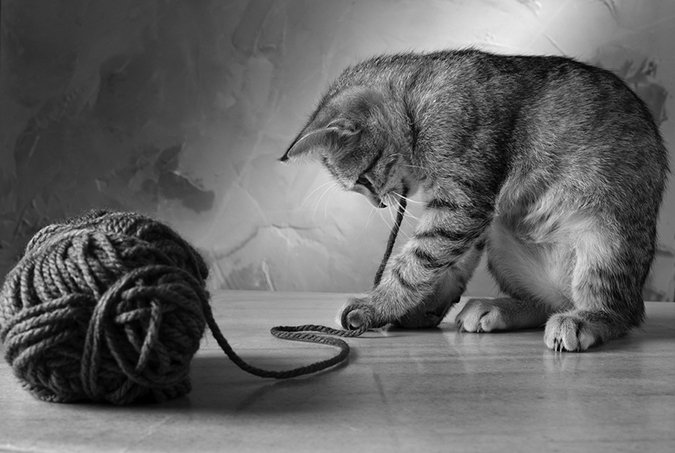Sometimes a cat’s bout of vomiting simply needs to run its course, similar to food poisoning or a viral GI bug in people. However, vomiting could indicate a significant medical problem, and if you’re concerned, it is always better to err on the side of caution and check with the veterinarian. Vomiting can be due to factors that directly affect the gastrointestinal tract or to indirect effects from other conditions, says Meredith L. Miller, DVM, ACVIM, a lecturer in small animal medicine at Cornell University College of Veterinary Medicine.
The most common reason, though, is dietary indiscretion. It can be due to eating something that passes normally but irritates the GI tract or causes an obstruction. “Cats in particular like to eat string or yarn, which have a high risk of becoming stuck in the intestines and causing a surgical emergency,” Dr. Miller says.
Underlying Diseases
Other common causes are gastroenteritis, intestinal parasites, food sensitivity/allergy, inflammatory bowel disease and gastrointestinal cancer. Secondary GI Diseases that may cause secondary vomiting include kidney and liver disease, pancreatitis and hormone imbalances.
© Noam Armonn | Bigstock

Excessive vomiting can lead to dehydration and electrolyte imbalances, which can affect normal cell function in a number of body systems. “Untreated, this can be seen as lethargy and potentially shock,” Dr. Miller says. As a board certified specialist in veterinary internal medicine, she offers the following advice:
Q. At what point should a vomiting cat see a veterinarian? Is it number of times vomited or the volume?
A. If your cat vomits and his belly seems painful, or he becomes listless or vomits for more than 24 hours, see a veterinarian. If your cat vomits but seems otherwise normal, withhold food for about six hours before offering his next meal. If your cat continues to vomit or doesn’t eat, then take him to the veterinarian.
Q. Should you be concerned about occasional vomiting?
A. Yes, even vomiting once a week is not normal and may indicate a chronic disease process. Vomiting very infrequently or only after a new food or getting into something are likely just isolated incidents.
Q. Are hairballs that cats ingest in grooming considered vomit?
A. Yes. This is typically a problem in longer-haired cats and can be treated by brushing frequently, trimming hair and giving hairball treats or diets. Hairballs can cause cats to feel ill or affect their appetite if it occurs often.
Q. What’s a cat’s posture when vomiting?
A. Vomiting usually has three phases: nausea in which a cat may withdraw, become quiet or drool; retching or stomach contractions; and finally forcefully expelling stomach contents.
This last point is important because it must be distinguished from regurgitation, a passive process in which esophageal contents are spit up. If you don’t see the cat doing it, we often assume it is vomit and not regurgitation. Vomiting is active and regurgitation is not. Generally, there is a delay between the start of retching and forceful expulsion of GI contents. Regurgitation occurs quickly with no warning. If you can’t tell the difference, film an event to show your cat’s veterinarian.
Q. Will a cat become sicker when vomiting is accompanied by diarrhea?
A. The same differential diagnoses can apply when diarrhea is involved. Cats may become dehydrated more quickly when they are experiencing vomiting with diarrhea. This is particularly true when the diarrhea and/or vomiting is bloody, as indicated by pink- or red-tinged vomit with fresh blood or diarrhea or vomit that resembles coffee grounds or dark tarry stools with digested blood.
Q. What should an owner do if there is blood in the vomit?
A. Vomiting blood can be seen with irritation from gastritis from things like dietary indiscretion. Persistent vomiting of blood may indicate a more serious problem like a bleeding disorder, gastric or small intestinal ulcer, bleeding tumor, or severe inflammation. Blood in vomit is a good reason to have your pet seen by a veterinarian.
Q. If the veterinarian finds bile in the vomit, what can be learned from testing the vomit?
A. Not much. Bile usually is more indicative of true vomiting than regurgitation. The pH can be tested, as stomach contents are very acidic, whereas esophageal contents should have a more neutral pH.
Q. What diagnostic tests are typically used for a pet that is vomiting?
A. Primary GI causes like an obstruction can be generally ruled out by taking abdominal radiographs (X-rays). If radiographs are questionable or show something abnormal, an abdominal ultrasound may be recommended to further look at the GI tract along with other abdominal organs. Secondary causes can begin to be ruled out with a complete blood count, serum biochemistry panel and urinalysis. Depending on results, further hormone tests or vitamin levels may be pursued.
Q. What medications are usually given first for a vomiting cat?
A. Most pets are treated with an antacid such as famotidine (Pepcid AC) or a true anti-nausea drug. Examples include maropitant (Cerenia) or ondansetron (Zofran). It is important to have a cat evaluated if the vomiting is severe or protracted, or he shows other signs of systemic illness before dispensing these medications as they may delay the diagnosis.
Q. How fast does the medication work?
A. Typically within a few hours. If the cat continues to vomit, seek veterinary care.



